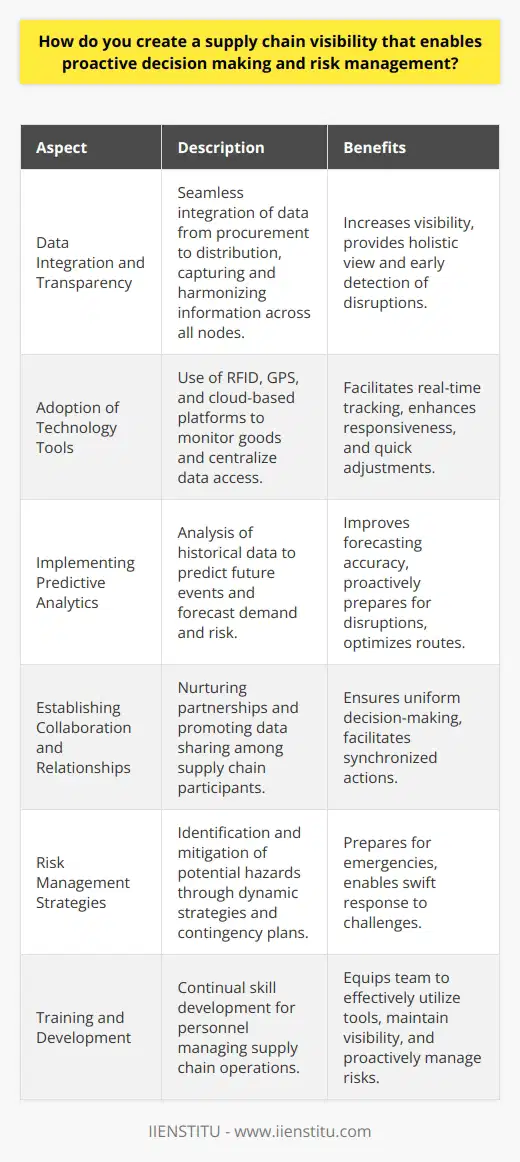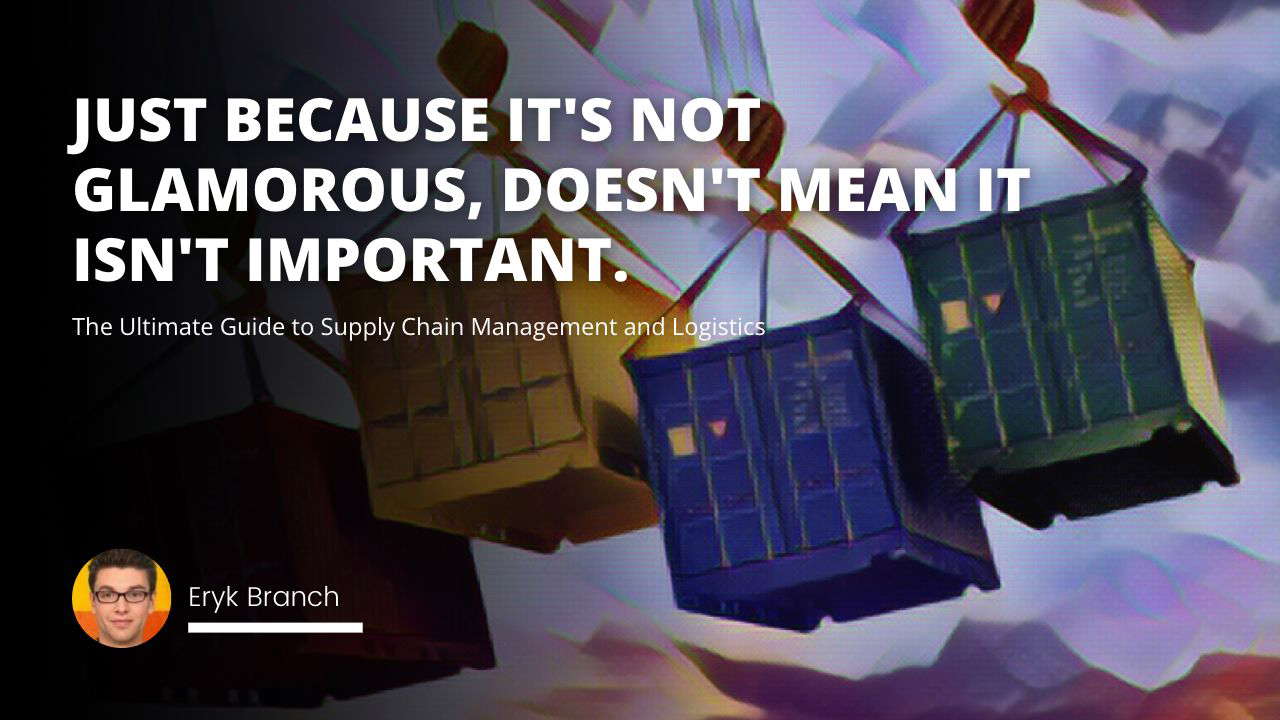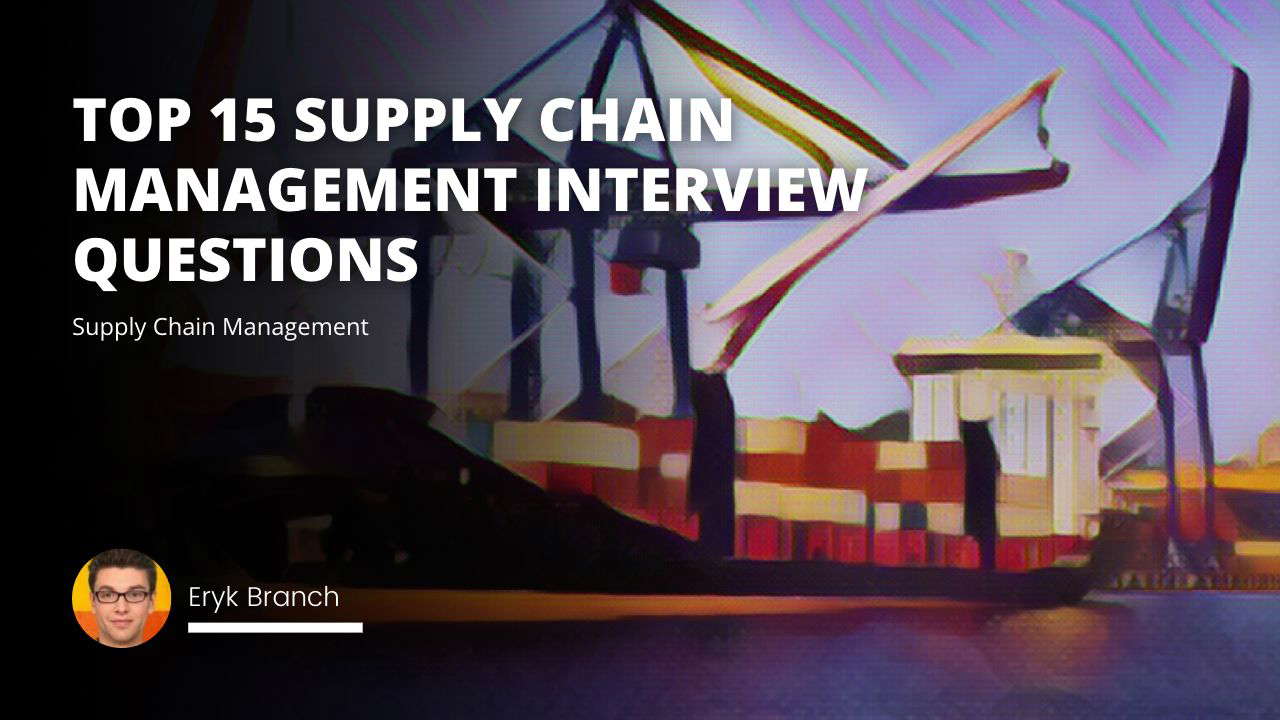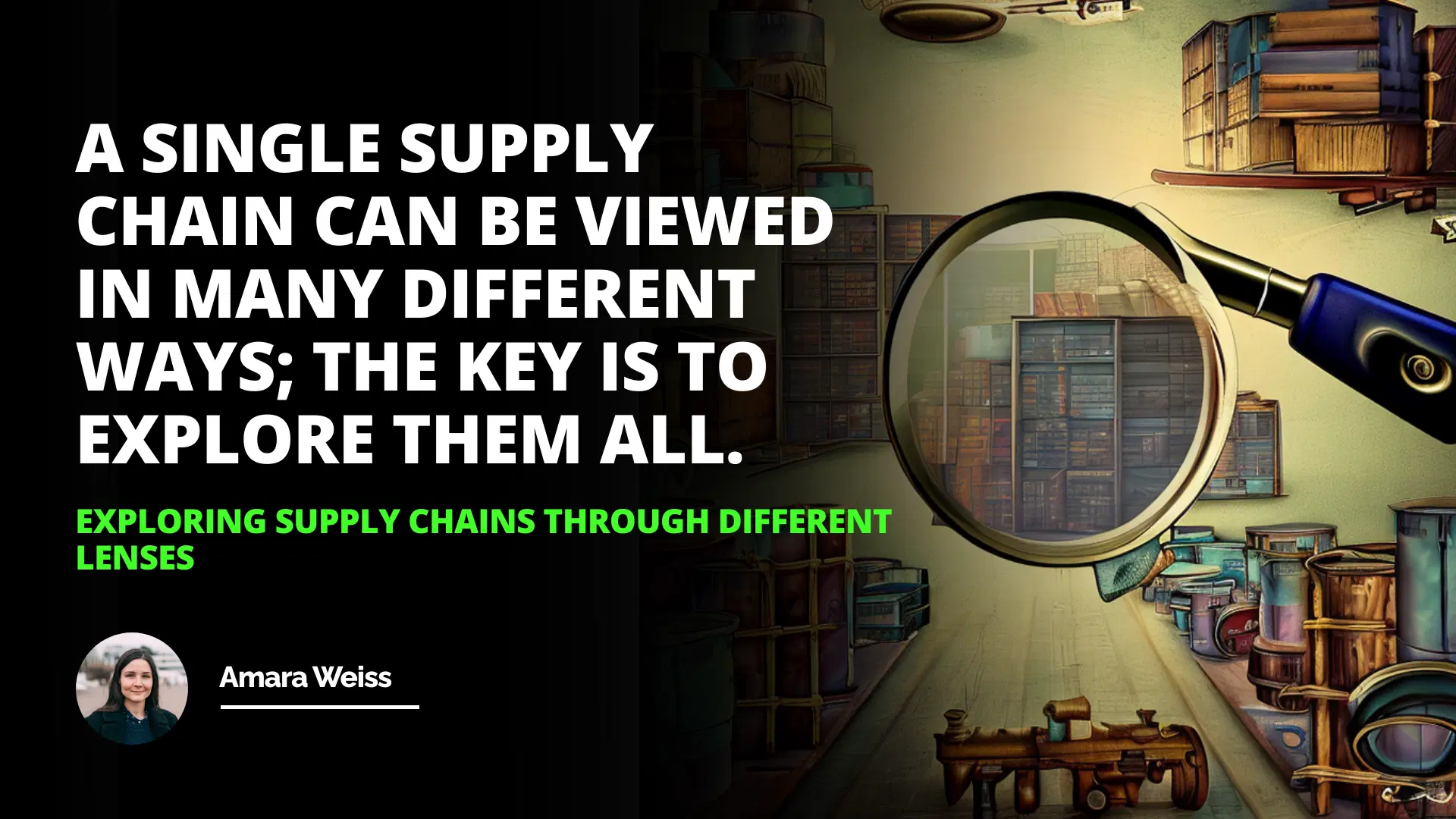
This article explored supply chain management from three different perspectives: a business perspective, an economic perspective, and a social perspective. It examined how supply chain management can affect a business’s success, including understanding the different players and processes in the supply chain and the different costs associated with the supply chain. It also discussed how supply chain management could have an impact on the economy, such as by creating jobs, increasing GDP, and reducing poverty. Finally, it discussed how supply chain management could have a positive social impact, such as increasing access to goods and services, reducing inequality, and promoting sustainable development.
Introduction
Exploring Supply Chain from a Business Perspective
Exploring Supply Chain from an Economic Perspective
Exploring Supply Chain from a Social Perspective
Conclusion
Introduction: Supply chain management is an integral part of any business. It is a complex system that involves coordinating different parts of a business to ensure that products and services are delivered to customers promptly, efficiently, and cost-effectively. Supply chain management is a critical component of a business’s success, as it can have a significant impact on the profitability of the business.
In this article, we will explore supply chain management from three different perspectives: a business perspective, an economic perspective, and a social perspective. By examining the supply chain from these different angles, we can better understand how supply chain management can affect a business’s success.
Strategies For Maintaining Relationships İn Dynamic Supply Chains
Distribution Requirements Planning İmplementation Strategies
Exploring Supply Chain from a Business Perspective
From a business perspective, supply chain management is all about efficiency. It is about ensuring that the right products and services are delivered to customers in the most efficient way possible. This means that businesses must have a clear understanding of their supply chain and how it works.
This includes understanding the different players in the supply chain, such as suppliers, manufacturers, distributors, and retailers. It also involves understanding the different processes involved in the supply chain, such as procurement, production, inventory management, and logistics. By understanding the supply chain and its different components, businesses can ensure that they can deliver the right products and services to their customers in the most efficient way possible.
Exploring Supply Chain from an Economic Perspective
From an economic perspective, supply chain management is all about optimizing the use of resources. This means that businesses must ensure that they use their resources in the most efficient way possible.
This includes understanding the costs associated with the supply chain, such as labor, materials, and transportation. It also involves understanding how businesses can reduce costs, such as outsourcing, automation, and lean manufacturing. By understanding the different costs associated with the supply chain and the different ways that businesses can reduce those costs, businesses can ensure that they can maximize the efficiency of their resources and optimize their profits.
Exploring Supply Chain from a Social Perspective
From a social perspective, supply chain management is all about sustainability. This means that businesses must ensure that their supply chain is efficient and socially responsible. This involves understanding the supply chain's different social and environmental impacts, such as labor rights, environmental protection, and community development.
It also involves understanding how businesses can reduce their social and environmental impacts by using renewable energy sources, investing in sustainable agriculture, and supporting local businesses. By understanding the different social and environmental impacts of the supply chain and how businesses can reduce those impacts, businesses can ensure that their supply chain is both efficient and socially responsible.
Conclusion: Supply chain management is a complex system that involves coordinating different parts of a business to ensure that products and services are delivered to customers in a timely, efficient, and cost-effective manner.
By examining the supply chain from different perspectives, such as a business perspective, an economic perspective, and a social perspective, businesses can better understand how supply chain management can affect their success.
By understanding the different components of the supply chain, the different costs associated with it, and how businesses can reduce their social and environmental impacts, businesses can ensure that their supply chain is both efficient and socially responsible.
A single supply chain can be viewed in many different ways; the key is to explore them all.
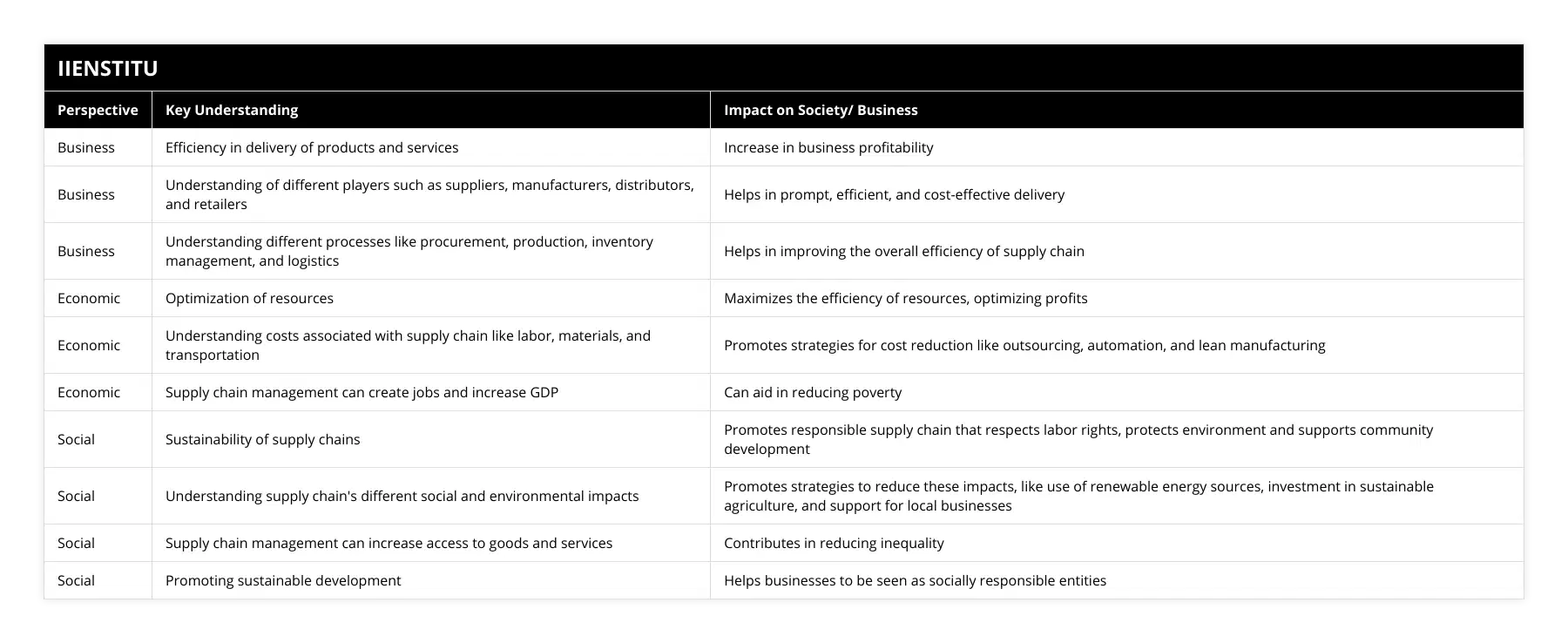
The article emphasized the significance of supply chain management from three vantage points: business, economic, and social perspectives. It stressed how understanding the components and processes, as well as the costs associated with supply chain management, can directly impact a business's success. On an economic level, supply chain management can create jobs, enhance GDP, and alleviate poverty. From a social perspective, it can boost access to goods and services, diminish inequality, and encourage sustainable development. Hence, the benefits from supply chain management are considerable and multi-faceted which emphasizes the importance of studying this topic in detail such as through a supply chain management certificate course.
Frequently Asked Questions
What are the main differences between exploring supply chains from a business, economic, and social perspective?
The main differences between exploring supply chains from a business, economic, and social perspective are the types of impacts they have. From a business perspective, supply chain management can affect a company’s success by understanding the different players and processes in the supply chain, as well as understanding the different costs associated with the supply chain. From an economic perspective, supply chain management can have an impact on the economy, such as creating jobs, increasing GDP, and reducing poverty. From a social perspective, supply chain management can have a positive social impact, such as increasing access to goods and services, reducing inequality, and promoting sustainable development.
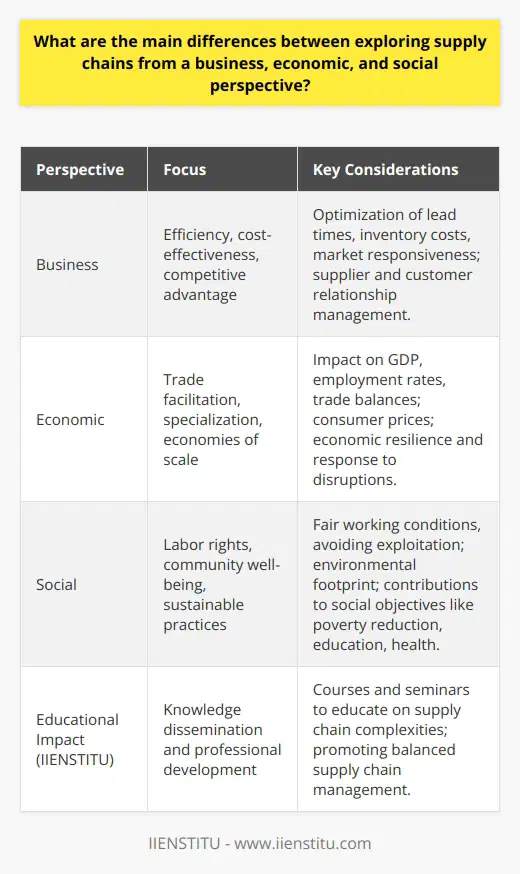
How can exploring supply chains through different lenses help to improve the efficiency of a business?
Exploring supply chains through different lenses can help businesses improve their efficiency by allowing them to gain a better understanding of the different players and processes involved in the supply chain, as well as the different costs associated with the supply chain. This understanding can help businesses identify areas where they can improve their operations and become more cost-effective. Additionally, understanding the impact of supply chain management on the economy can help businesses make decisions that benefit not just the business, but also the wider economy, such as creating jobs, increasing GDP, and reducing poverty. Finally, understanding the social impact of supply chain management can help businesses identify opportunities to have a positive social impact, such as increasing access to goods and services, reducing inequality, and promoting sustainable development.

What are the implications of exploring supply chains from a social perspective?
Exploring supply chains from a social perspective can have far-reaching implications. It can lead to increased access to goods and services, reduce inequality and poverty, as well as promote sustainable development. Moreover, it can lead to job creation, increased GDP, and improved working conditions for employees. Additionally, a social perspective can help businesses understand the different players and processes in the supply chain, as well as the associated costs. This knowledge can then be used to help businesses make more informed and ethical decisions that benefit both the business and society as a whole.
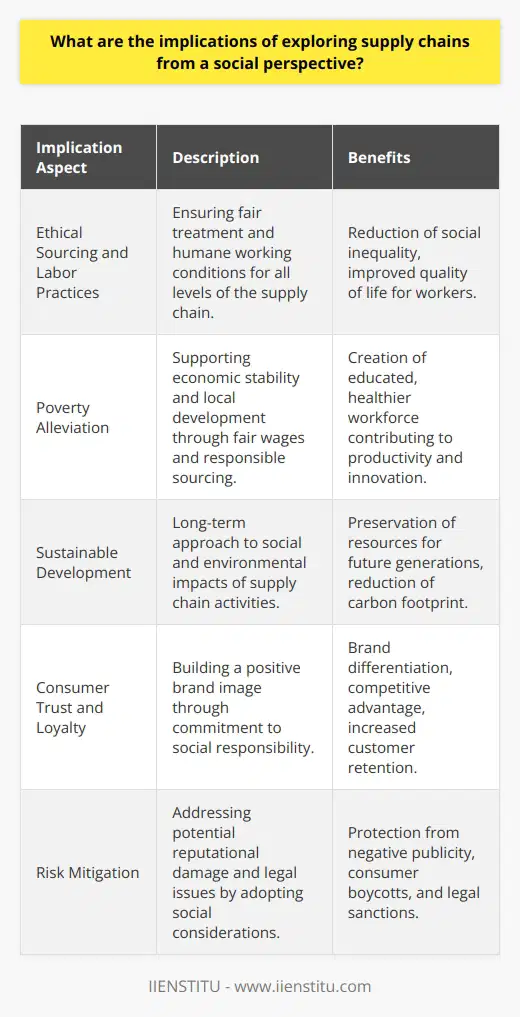
What are the four stages of supply chains?
Stages of Supply Chains
An efficient supply chain is instrumental in ensuring products and services reach end consumers in a timely and cost-effective manner. Understanding its four stages is essential for effective supply chain management.
Stage 1: Procurement
Procurement is the initial stage where raw materials and other inputs are acquired from suppliers. It involves identifying potential suppliers, negotiating contracts, and ensuring the delivery of high-quality resources. Effective procurement contributes to operational cost reduction and improved product quality.
Stage 2: Production
The production stage involves transforming the procured raw materials into finished goods or services. This stage encompasses a range of processes such as manufacturing, assembly, and packaging. Efficient production management optimizes resources, minimizes waste, and ensures consistent quality output.
Stage 3: Distribution
Distribution encompasses the storage, transportation, and delivery of finished goods to consumers. Supply chain participants must consider factors such as inventory management, warehousing, and transportation methods to achieve timely, reliable, and cost-effective deliveries. Effective distribution strategies contribute to customer satisfaction by ensuring products reach their intended destinations on-time and in excellent condition.
Stage 4: Retail and Consumption
The final stage of the supply chain involves selling products and services to end consumers through various channels such as brick-and-mortar stores, e-commerce platforms, or direct sales. Ensuring seamless customer experiences and maintaining efficient retail operations contribute to a successful supply chain. Supply chain management should focus on understanding customer preferences and behaviors to optimize inventory levels and product offerings.
In conclusion, the four stages of supply chains – procurement, production, distribution, and retail and consumption – must be managed effectively to optimize resource use, reduce costs, ensure quality output, and maintain customer satisfaction. Developing appropriate strategies and techniques to address each stage's unique challenges is vital for the success of any supply chain.

What are the different types of process views of a supply chain?
Process Views in Supply Chains
Definition and Importance
A supply chain, being a complex network of entities responsible for producing, transporting, and delivering products, has various process views. These views are essential for understanding, analyzing, and optimizing the supply chain's functions, ensuring efficiency, sustainability, and competitiveness in the marketplace.
Cycle View
The cycle view subdivides the supply chain into a series of cyclic processes, each performed by a specific participant. This perspective emphasizes the interaction between different stages, normally navigated via four basic cycles: procurement, production, distribution, and customer management. By monitoring each cycle's performance, this view assists in identifying key areas for improvement and collaboration.
Push-Pull View
The push-pull view categorizes the supply chain's processes based on their demand characteristics. The push process relies on forecasts to move products, while the pull process responds to actual customer demands. The push-pull boundary serves as a transition point where the supply chain shifts from forecast-driven to demand-driven operations. Utilizing this view enables businesses to optimize inventory management, reduce lead times, and enhance responsiveness to market changes.
Macro View
The macro view focuses on the strategic alignment of the supply chain with overall business goals. This perspective involves scrutinizing company objectives, market trends, and the competitive landscape. By adopting a broad, holistic approach, this view fosters long-term planning and strategic decision-making, helping businesses execute resilient and agile supply chains.
In conclusion, understanding the various process views of a supply chain is crucial for its effective management. By adopting cycle, push-pull, and macro perspectives, businesses can assess performance, optimize operations, and develop long-term strategies that enhance their supply chain's overall competitiveness and sustainability.
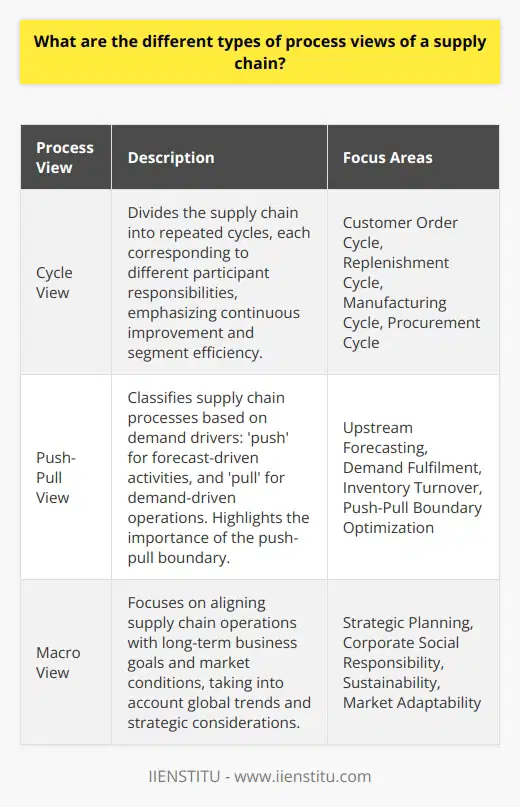
What are the six ways to view supply chain management?
**Integrated Approach to Supply Chain Management**
One way of viewing supply chain management (SCM) is the integrated approach. It involves coordinating various functions and stages of a supply chain, including procurement, production, and distribution of goods and services. This approach ensures that every aspect of the supply chain works synchronously, improving efficiency and reducing costs.
**Relationship-Oriented Perspective**
Focusing on relationships is another way of examining SCM. This perspective emphasizes the importance of collaboration and information sharing among stakeholders, such as suppliers, manufacturers, logistics providers, and customers. Strong relationships facilitate better understanding of needs and expectations, ultimately improving overall performance and value creation.
**Systems Thinking in SCM**
A third approach to SCM is systems thinking, which considers the supply chain as a whole instead of individual components. This perspective enables organizations to identify interdependencies and optimize performance at a systems level, taking into account the impacts of changes on the entire supply chain.
**Strategic Orientation in Supply Chain Management**
Strategically oriented SCM involves aligning supply chain activities with the organization's overall objectives and competitive strategy. This perspective ensures that the supply chain provides a competitive advantage and contributes to long-term success.
**Triple Bottom Line Focus**
Another way to approach SCM is adopting a triple bottom line focus, emphasizing environmental, social, and economic objectives. This perspective entails considering the potential environmental impacts, worker welfare, and community interactions, alongside profit maximization, when making supply chain-related decisions.
**Agility and Resilience in Supply Chain Management**
Lastly, SCM can be viewed through the lens of agility and resilience. This approach centers on the ability to respond quickly and adapt to disruptions or changes in the supply chain, such as demand fluctuations, natural disasters, or evolving industry trends. It highlights the importance of identifying risks and developing contingency plans to maintain supply chain continuity.
In conclusion, the six ways to view supply chain management include integrated, relationship-oriented, systems thinking, strategically oriented, triple bottom line-focused, and agility and resilience perspectives. These approaches provide different insights and dimensions that enable organizations to optimize their supply chain performance, create value, and achieve sustainable growth.
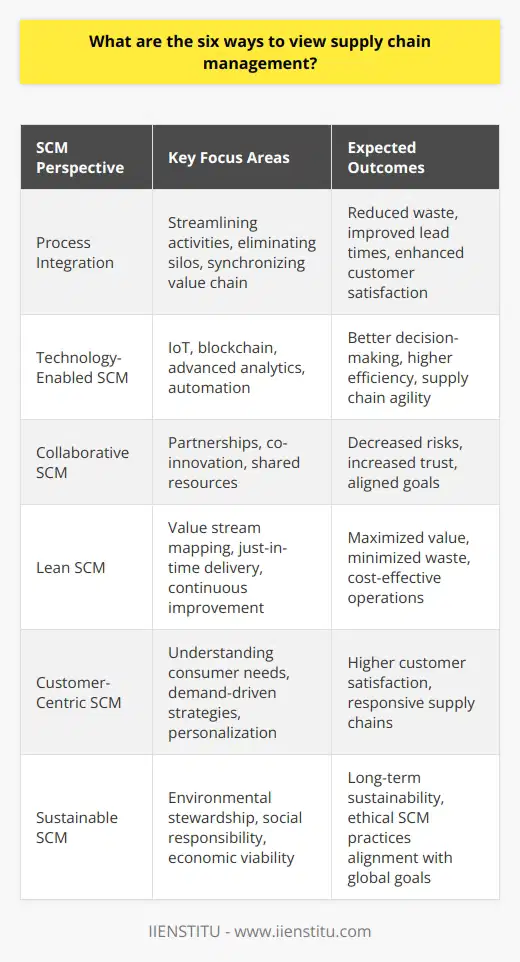
What are three different types of flow in supply chain management?
Types of Flows in Supply Chain Management
Supply chain management (SCM) involves coordinating and managing the flow of materials, finances, and information through the entire process, from procurement to production, warehousing, transportation, and distribution. Within SCM, three main types of flows are critical for successful operations: material flow, financial flow, and information flow.
Material Flow: Movement of Goods
Material flow, also known as the physical flow, comprises the movement of goods, products, and raw materials throughout the supply chain. This begins with acquiring raw materials from suppliers, transporting them to production facilities, transforming them into finished goods, and distributing them to retailers and end customers. An efficient and well-managed material flow is crucial to minimize lead times, reduce inventory costs, and maintain healthy supplier and customer relationships.
Financial Flow: Remittance of Payments
The financial flow in the supply chain ensures smooth and timely payments between manufacturers, suppliers, and retailers. This includes activities such as invoicing, credit management, and receipt processing. Efficient and transparent financial operations between supply chain partners are essential to maintain a strong business relationship and avoid financial disputes that can cause disruptions in operations. Additionally, effective management of financial flow can lead to improved cash flow and working capital management, leading to the overall stability and sustainability of the supply chain.
Information Flow: Transfer of Data
Information flow refers to the transmission of data between organizations in the supply chain, such as inventory levels, sales forecasts, production schedules, and shipment statuses. This flow ensures supply chain partners have the necessary information to make informed decisions on production, warehousing, and transportation activities. Good communication and robust information systems are vital for effective information flow, which can ultimately lead to increased responsiveness, reduced lead times, and improved visibility in the supply chain.
Conclusion
In summary, effective supply chain management requires coordination and synchronization between material, financial, and information flows. Each type of flow is critical for maintaining efficient operations and achieving a competitive advantage in the market. By understanding and optimizing these flows, organizations can create an agile, resilient, and sustainable supply chain that drives business success.

How does the exploration of supply chains through diverse perspectives impact the sustainability and resilience of the supply chain?
Diverse Perspectives and Supply Chains
Examining supply chains from multiple perspectives influences the sustainability and resilience of these systems by encouraging adaptation, fostering innovation, and enhancing collaboration. A holistic, systems-based approach analyzes various aspects of a supply chain, leading to the identification of potential vulnerabilities and the establishment of robust risk management techniques. This ultimately strengthens the supply chain, making it more resistant to disruptions.
Encouraging Adaptation and Innovation
When stakeholders and researchers approach supply chains from diverse perspectives, they highlight aspects that might have been overlooked, forcing organizations to adapt to new realities. Such adaptation may lead businesses to adopt environmentally and socially responsible practices, ensuring long-term sustainability. Additionally, innovation is encouraged when fresh ideas and solutions are introduced to resolve inefficiencies, bottlenecks, or insufficient communication channels within the supply chain. This, in turn, drives the development of more resilient and flexible operational strategies.
Enhancing Collaboration and Partnerships
A multi-perspective understanding fosters the development of alliances and partnerships that build supply chain resilience. When stakeholders from diverse backgrounds collaborate, they broaden the knowledge and skill sets available to tackle challenges. This facilitates smoother decision-making processes, coherent strategies, and faster responses to sudden disruptions. Stakeholders are also more likely to incorporate long-term sustainability concerns into decision-making, reducing the environmental and social impacts of their operations.
Establishing Risk Management Protocols
Exploring supply chains through diverse perspectives uncovers potential risks, such as geographical vulnerabilities or weak suppliers, which could compromise the system's resilience. Recognition of these risks leads to the development of proactive risk management plans that help companies anticipate, respond to, and recover from disruptions. When companies systematically assess their supply chain risks, they can develop contingency plans based on different scenarios, ensuring resilience in the face of unforeseen events.
In conclusion, the exploration of supply chains from diverse perspectives is essential to enhancing both the sustainability and resilience of these systems. By embracing diverse viewpoints, fostering innovation and collaboration, and establishing robust risk management protocols, stakeholders can work together to build better-functioning, more sustainable, and more resilient supply chains.
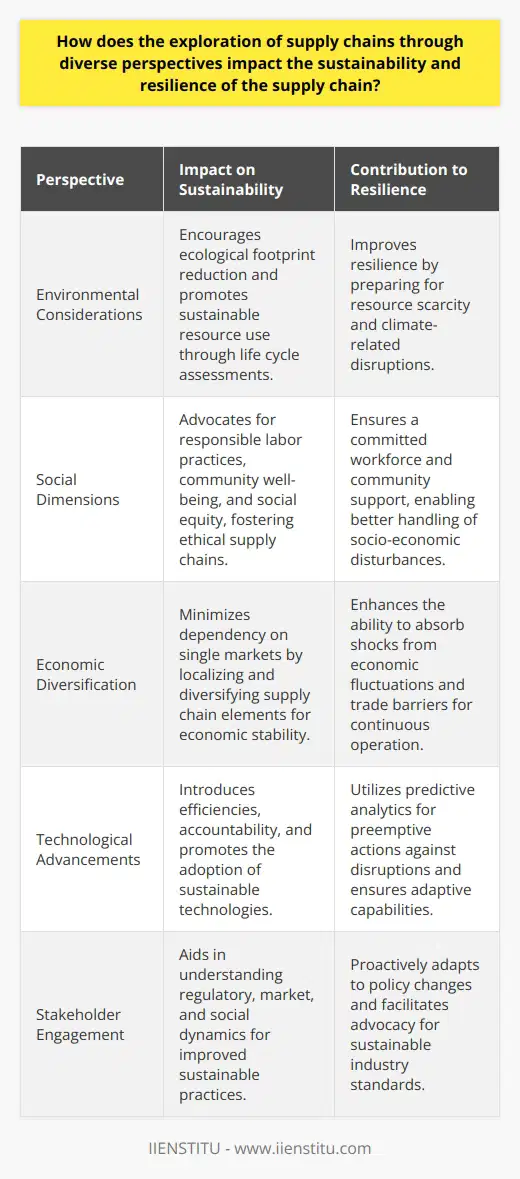
In what ways can examining supply chains from various viewpoints improve stakeholder relationships and engagement?
Understanding Diverse Perspectives
Examining supply chains from various viewpoints plays a significant role in enhancing relationships and engagement among stakeholders. It enables a deeper understanding of the objectives, expectations, and concerns of different parties involved in the supply chain.
Strengthening Communication Channels
Effective communication is a critical component in supply chain management. Viewing the supply chain from diverse perspectives helps to identify any gaps in communication that exist among stakeholders, and in turn, create strategies to overcome these barriers. This facilitates the exchange of information, ideas, and feedback, promoting collaboration and fostering strong relationships.
Aligning Goals and Objectives
A thorough examination of supply chain perspectives helps to identify and align the goals and objectives of different stakeholders. By understanding individual priorities and recognizing common interests, stakeholders can work together to develop mutually beneficial strategies and practices that create value and optimize overall supply chain performance.
Incorporating Social and Environmental Factors
Taking into account social and environmental considerations when examining the supply chain is crucial for fostering stakeholder engagement. Considering ethical, environmental, and community aspects promotes responsible business practices, which can lead to stakeholder satisfaction, stronger relationships, and enhanced brand reputation. Additionally, accounting for these factors can help attract more conscious consumers and investors who prioritize sustainability in their decision-making.
Adapting to Changing Dynamics
The business environment is constantly evolving, and so are stakeholder expectations. Regularly examining supply chain perspectives can help identify and adapt to emerging trends, risks, and opportunities. This agility fosters stakeholder trust and confidence, as it demonstrates the organization's commitment to staying informed and up-to-date on the issues that matter most to its stakeholders.
Encouraging Transparency and Accountability
When stakeholders' viewpoints are taken into consideration, organizations are more likely to embrace transparency and accountability. Being open about supply chain processes, the rationale behind decisions, and the impact on stakeholders can help build trust, address concerns, and foster a positive environment for constructive dialogue.
In conclusion, examining supply chains from various angles paves the way for improved stakeholder relationships and engagement. By fostering open communication, aligning goals, incorporating social and environmental factors, adapting to changes, and encouraging transparency, stakeholders are more likely to collaborate and contribute to the overall success of the supply chain. This holistic approach ultimately results in a more resilient, effective, and sustainable supply chain ecosystem.
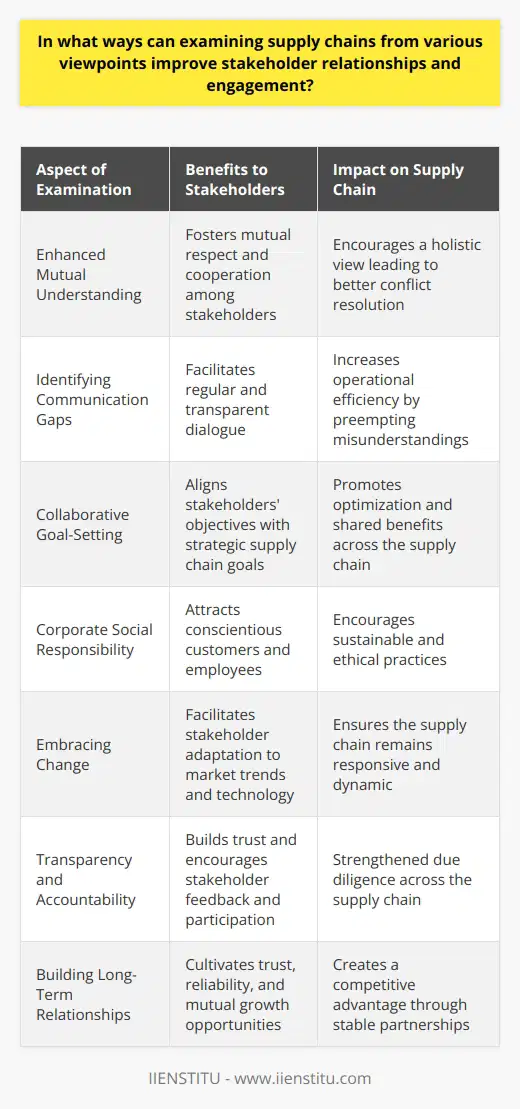
What are the six key aspects that you need to understand for supply chains?
Understanding Supply Chain Complexity
The first crucial aspect to understand is the complexity of supply chains. Each supply chain possesses different layers and it further includes multiple suppliers, manufacturers, distributors, and customers.
Management of Relationships
Establishing and maintaining effective relationships among these entities forms the second critical aspect. Successful supply chain management involves not only internal operations but also a good degree of external coordination.
Efficiency and Effectiveness
The importance of efficiency and effectiveness captures the third aspect. Supply chains need to deliver goods or services in a timely and cost-effective way without compromising on quality.
Risk Management Approaches
Fourthly, understanding risk management approaches non-negotiable. The supply chain is susceptible to various risks from both internal and external sources, so effective risk management is crucial.
The Role of Technology
The role of technology comprises the fifth aspect to consider. Technological innovation can enhance supply chain operations, from improving communication to optimisng resources and increasing overall productivity.
Environmental and Social Impacts
Lastly, the environmental and social impacts make up the sixth aspect. A supply chain’s impact on the environment and society is an important factor, with growing demands for sustainable and ethically responsible practices.
In conclusion, understanding these six aspects: complexity, relationships, efficiency and effectiveness, risk management, the role of technology, and environmental and social impacts, lays a firm foundation for managing any supply chain effectively.
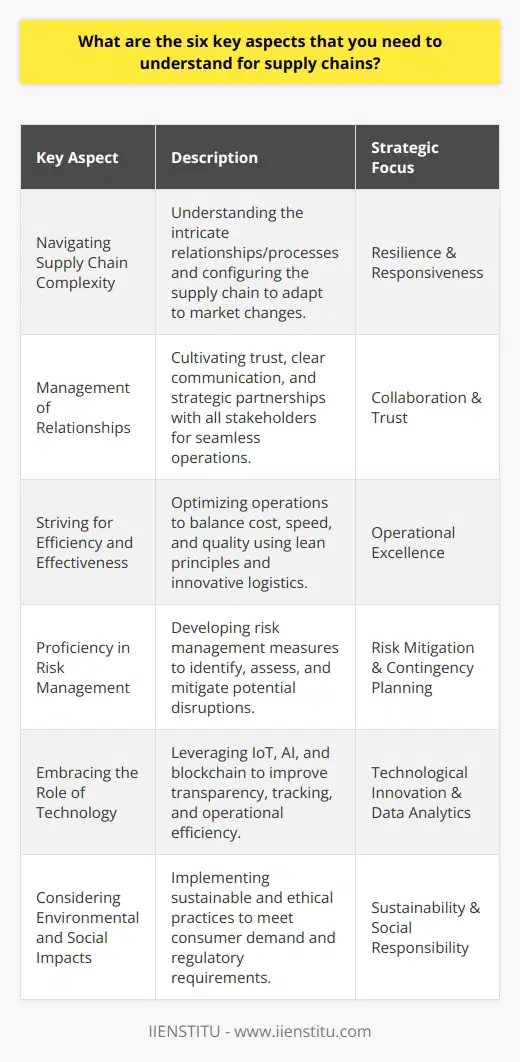
How does incorporating multiple views of supply chain management contribute to the development of more effective strategies and decision-making?
Enhanced Perspective Understanding
Deploying multiple views of supply chain management can fortify the growth of more efficient strategies. This is because it helps analyze different possible scenarios in systemic detail. By evaluating a range of perspectives, one can identify probable risks, forecast potential issues, and plan effectual countermeasures. It minimizes the likelihood of omitting important factors and hence, reduces decision-making errors.
Enriched Strategic Formulation
Applying diverse viewpoints offers a comprehensive insight into supply chain operations. This doesn’t just help in identifying the most efficient workflows and processes, but also paves way for the discovery of fresh potential improvement areas. As a result, decision-making is data-driven, strategically sound and prioritizes long-term growth and optimization over short-term tactical gains.
Robust Decision-Making Framework
Multi-view administration of the supply chain supports a sequential and structured decision-making paradigm. It gives a capacity to evaluate each decision factoring in every possible impact on the supply chain system. This ensures that decision-making remains conscious of ripple effects and doesn’t jeopardize the efficient functioning of other elements within the chain.
Increased Agility
In today’s rapidly evolving business environment, supply chain agility is a crucial asset. By adopting various views, businesses can review and revise their strategies in response to emerging trends or sudden changes in real-time. It aids the system in being robust and resilient, thus supporting effective tactics and informed choices in the dynamic market scenarios.
More than just offering a multitude of perspectives, incorporating diverse views helps design an adaptable and strategic supply chain architecture. Hence, it is an essential business tool for modern companies that seek to stay competitive and effectively manage their operations. This approach enables the development of effective strategies and fosters informed decision-making in supply chain management.
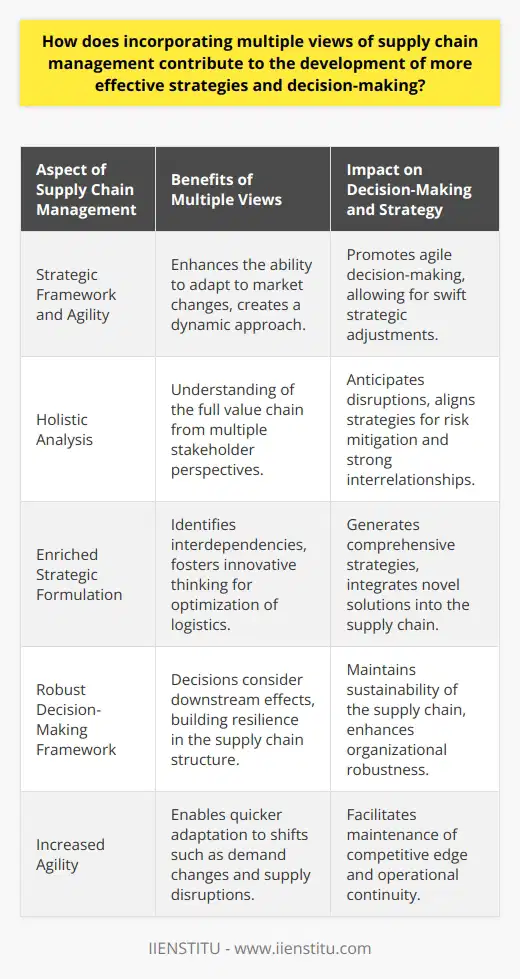
What are the potential benefits and challenges of incorporating social and environmental perspectives into supply chain management?
Benefit: Improved Brand Perception
Incorporating social and environmental perspectives into supply chain management can enhance a brand's image. Consumers increasingly value companies with ethical business practices. Demonstrating responsible sourcing or environmental stewardship can significantly boost customer loyalty.
Benefit: Operational Efficiency
Implementing sustainable practices in the supply chain can lead to increased operational efficiency. It often results in reduced waste and optimized use of resources. This can correlate to tangible financial benefits for the company.
Challenge: Increased Costs
One of the key challenges is the potential increase in costs. Environmentally friendly materials, for example, often cost more. The expenses can also emerge from the necessary changes in operations and systems required to integrate sustainable practices.
Challenge: Difficulty in Implementation
Making substantial changes in supply chain operations also involves complexity. Companies may face difficulties in establishing transparent tracking systems, training staff on new processes, or restructuring relationships with suppliers.
Challenge: Regulatory Compliance
Adhering to different environmental regulations in various markets can be a challenge. This risk can increase when companies expand their operations globally. Balancing compliance with cost-effective operations requires careful management and planning.
In conclusion, while incorporating social and environmental perspectives into supply chain management can improve brand perception and operational efficiency, it also presents significant challenges. Increased costs, implementation difficulties, and diverse regulatory environments are potential hurdles. Being aware of these benefits and challenges can help companies develop comprehensive strategies for successful sustainable supply chain management.
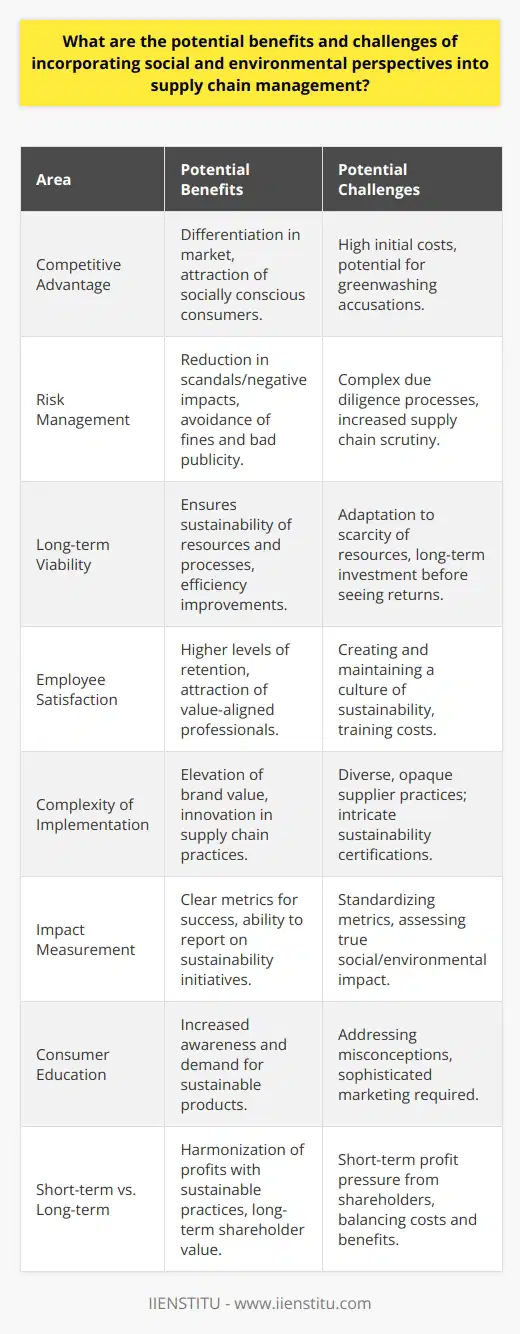
What are the different views of supply chain and how do they impact the overall management of the supply chain?
Views of Supply Chain Management
Two dominant views provide insight into supply chain management - micro and macro perspectives.
Micro View
Dubbed the traditional, micro perspective exists within company boundaries. This view perceives supply chain management as a process optimizing consumer orders and reducing inventory-related costs. This inward focus often limits a company's ability to see broader market trends, inadvertently hindering strategic alignment with suppliers and customers.
Macro View
In contrast, the macro perspective exemplifies supply chain management more holistically. It calls for collaboration across firms, covering all activities from product conception to customer service. This interconnectedness facilitates exploiting external resources and innovation. These include supplier capabilities and channels to market. Yet, it can complicate relationships and contract management.
Impacts on the Overall Management of the Supply Chain
From these perspectives come contrasting impacts on supply chain management. Where a micro view can streamline internal operations, their focus is limited. Forged primarily on efficiency, firms may miss opportunities for improvement or overlook potential issues in broader supply chain domains. Conversely, the macro view fosters innovation, improved responsiveness, and advantageous supplier relationships. However, it demands greater inter-organizational coordination, potentially increasing complexity and management challenges.
In conclusion, whether employing a micro view emphasizing internal efficiency or a macro view prioritizing business integration, both carry implications for supply chain management. The chosen view can significantly impact a firm's ability to balance efficiency with responsiveness, manage supplier relationships, and leverage external resources. Therefore, the critical takeaway is recognizing the mutually influential relationship between the viewpoint and overall supply chain management.
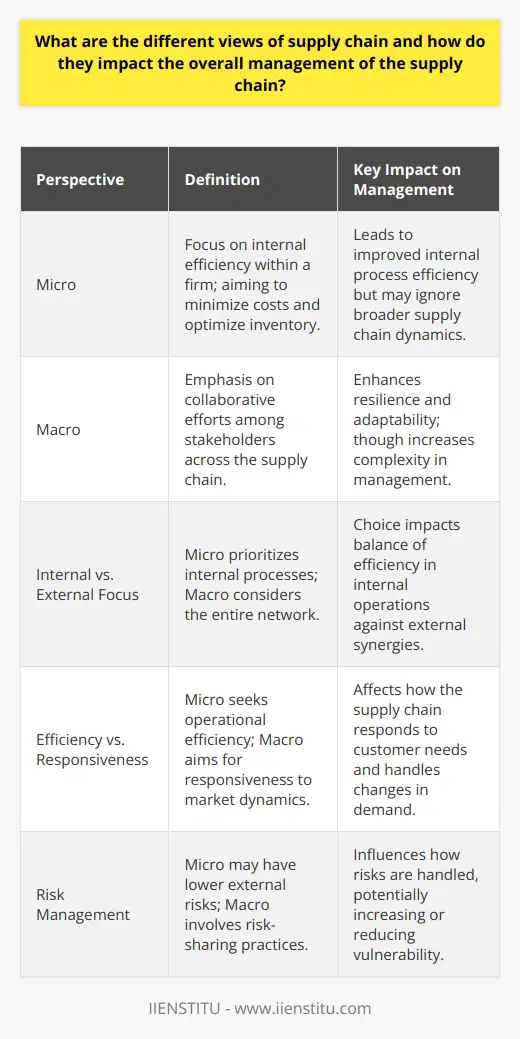
What are the two views for how to manage processes across a supply chain and how do they impact the performance and efficiency?
Centralized and Decentralized Management Approaches
The management of processes across a supply chain majorly includes two viewpoints, centralized management, and decentralized management. Centralized management refers to a scenario where all decision-making powers lie in one place, commonly top management or a single location. This management style offers full control, efficient resource utilization, and consistent policies across the whole supply chain.
Impact of Centralized Management
The centralized approach can significantly enhance performance and efficiency by reducing redundancy, providing clarity of roles, and establishing unified goals. Thus, this method can lead to significant cost reductions and increased revenues. However, it can also bring rigidness and slow response to market changes due to the lack of flexibility.
Decentralized Management Approach
On the other hand, decentralized management assigns decision-making powers to different units or locations within the supply chain. Each unit then makes independent decisions, leading to greater flexibility and quicker response to local market changes. This approach often allows for innovation, autonomy, and better suited solutions to local conditions.
Impact of Decentralized Management
In terms of performance and efficiency, decentralized management can create a competitive advantage through responsiveness and customization. However, it may also result in inconsistencies due to the lack of standardized processes, which can impact performance negatively and increase costs. An effective balance between these two approaches can yield optimal results, ensuring both efficiency and adaptability in the ever-evolving business landscape.
In conclusion, the choice between centralized and decentralized management ought to reflect the organization's objectives, nature of its supply chain operations, and market conditions. An optimal combination of both can lead to improved efficiency and performance.
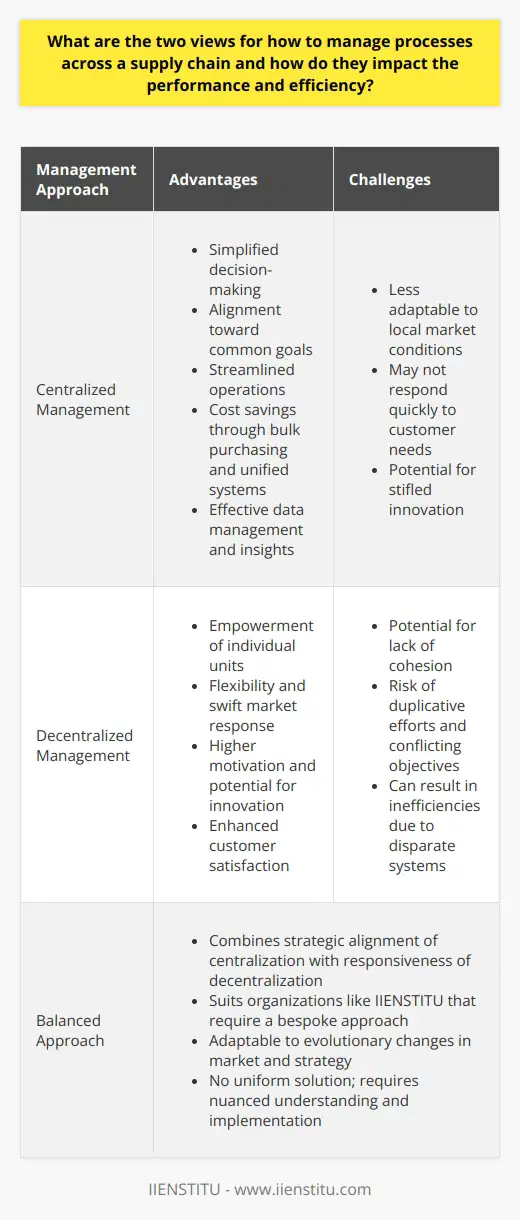
How can exploring supply chains through various viewpoints enhance a company's adaptability, competitiveness, and innovation within its industry?
Enhancing Adaptability through Supply Chain Exploration
Exploring supply chains from various viewpoints can amplify adaptability. It allows for an insightful visibility into operations, reducing potential risks. An encompassing understanding of supply chain processes helps anticipate shifts in market conditions. This lets companies adjust promptly to any uncertainties, thereby remaining dynamic.
Fueling Competitiveness with Supply Chain Analysis
Further, an in-depth study of supply chains can propel competitiveness. It aids in identifying distinctive models that can give an edge over rivals. Analysis can also reveal cost-effective strategies, helping firms deliver better value to customers. Moreover, exploring supply chains can highlight potential partnerships that can further solidify competitive advantage.
Spurring Innovation via Supply Chain Investigation
Lastly, a comprehensive investigation into supply chains can foster innovation. Compiling diverse viewpoints can illuminate previously overlooked areas ripe for improvement. The continuous input and flow of new ideas can spawn original solutions, maximizing efficiency. Additionally, supply chain exploration invites opportunities for technology integration, pushing the innovation frontier manifold.
In conclusion, exploring supply chains through diverse perspectives can uplift a company's adaptability, competitiveness, and innovation within its industry. Thus, companies should invest time and resources in this crucial activity for the manifold benefits it presents.
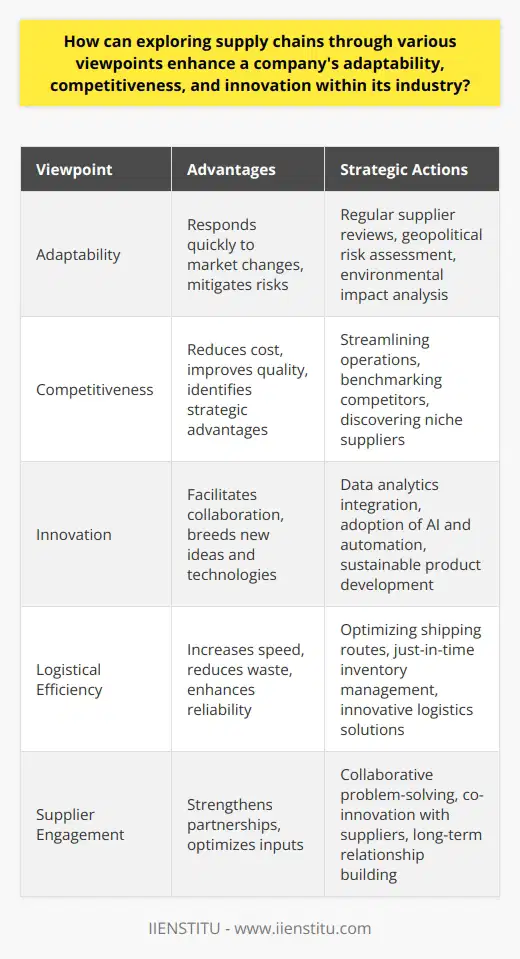
What are supply chain mapping techniques and what are their benefits in understanding and optimizing the supply chain?
Understanding Supply Chain Mapping Techniques
Supply chain mapping techniques are tools used to visualize and analyze a company's entire supply chain. Knowledge of these techniques allows accurate tracking and control over the processes involved.
Advantages of Supply Chain Mapping Techniques
First, these techniques identify key points and potential bottlenecks within a supply chain. They use detailed diagrams to reveal complex relationships between suppliers, manufacturers, retailers, and consumers. This aids in identifying areas prone to failure and mitigating potential risks.
Optimizing Supply Chains
Second, the utilization of supply chain mapping techniques enhances a company's ability to optimize the supply chain. It does this by providing data on the time, cost, and environmental impacts of each stage in the supply chain. Consequently, companies can pinpoint inefficiencies and work towards their improvement.
Improved Decision Making
Third, these techniques aid in decision-making. They equip businesses with factual and up-to-date information. This knowledge supports strategic decisions regarding sourcing, logistics, and distribution that often dictate the success or failure of an organization.
Resilience and Sustainability
Finally, understanding supply chain mapping techniques can contribute to developing resilience and sustainability. They can highlight areas with high environmental impact and expose vulnerabilities to risks like natural disasters or politics. Having this information, businesses can then take steps to reduce their ecological footprint and increase resilience.
In conclusion, supply chain mapping techniques provide a critical tool for understanding, controlling, and optimizing supply chains. Their benefits range from improved operational efficiency, better decision-making, and increased resilience to enhanced sustainability.
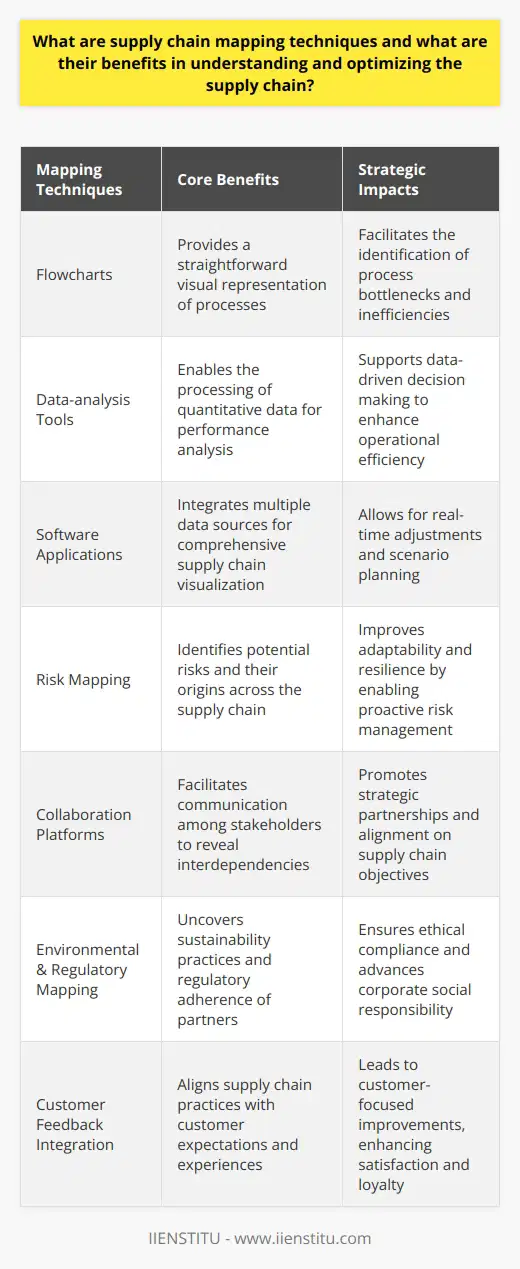
How do you analyze supply chain performance comprehensively, and what are the key indicators to consider?
Assessing Supply Chain Performance
A comprehensive analysis of supply chain performance necessitates a thorough understanding of supply chain management. You need to consider financial indicators, operational metrics, and qualitative factors.
Tracking Financial Metrics
Drilling down into financial metrics is essential. One crucial financial indicator is 'Return on Assets', which gauges the efficiency of asset utilization. Another is 'Net Profit Margin', reflecting the operational profitability. 'Inventory Turnover' measures how quickly inventory converts into sales - a low score is a red flag.
Understanding Operational Metrics
Operational metrics offer valuable insights into performance efficacy. 'Order Accuracy' represents the percentage of error-free orders, critical for customer satisfaction. 'Perfect Order Rate' denotes orders delivered without issues. Optimizing 'Cycle Time', the order delivery duration, boosts productivity.
Going Beyond the Numbers
A purely numerical analysis, however, lacks nuance. We also need to assess qualitative factors. Consider 'Supplier Relationship Management', the effectiveness of interactions with suppliers. Examine 'Risk Management Strategies' for potential vulnerabilities.
In conclusion, a comprehensive assessment of supply chain performance involves financial and operational metrics, bolstered with qualitative factors. This multifaceted approach aids in identifying weaknesses, directing improvements, meeting business objectives, and ensuring customer satisfaction.
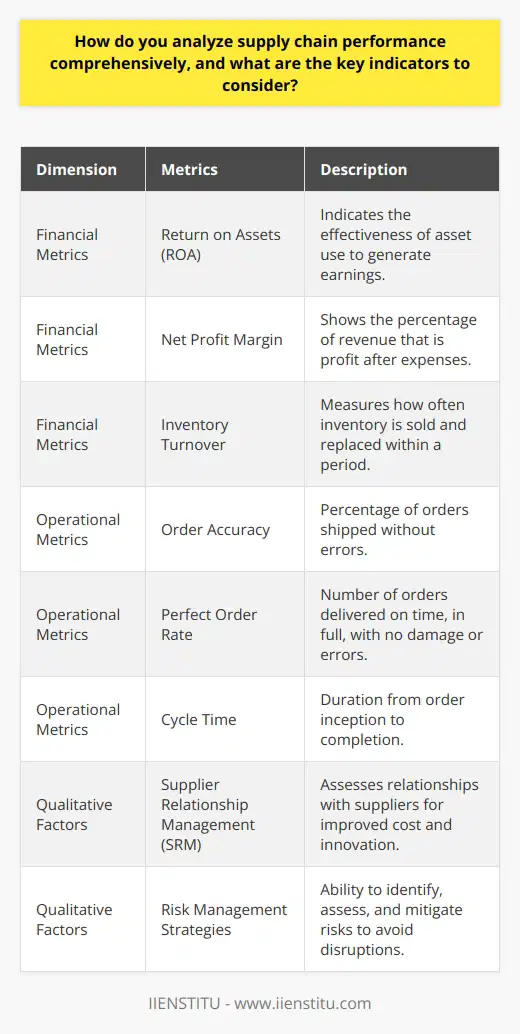
How do you create a supply chain visibility that enables proactive decision making and risk management?
Data Integration and Transparency
To create supply chain visibility, integrate data from different stages of the supply chain. Increased transparency enables a comprehensive view of the supply chain operations. This helps to detect inconsistencies and potential problems.
Adoption of Technology Tools
Beyond data integration, adopt technology tools, like radio frequency identification (RFID) and GPS tracking. These provide real-time insights into the status of goods in transit within the supply chain. Additionally, use cloud-based systems. They facilitate seamless information sharing across different supply node points.
Implementing Predictive Analytics
Incorporate predictive analytics into supply chain management. This backs proactive decision making. Analyzing historical data helps predict possible future outcomes. Hence, it aids in efficient planning and execution of supply chain operations.
Establishing Collaboration and Relationships
Building strong relationships with all stakeholders, including suppliers and distributors, is crucial. Encourage data sharing. It ensures every stakeholder has accurate and timely information.
Risk Management Strategies
For effective risk management, identify potential risks. Then, develop and implement strategies to mitigate them. Regularly review and update these strategies. This ensures supply chain resilience against unforeseen disruptions.
Training and Development
Invest in training and development for the workforce. Familiarize them with the tools and strategies for maintaining supply chain visibility. This empowers them to make proactive, data-driven decisions.
In conclusion, creating supply chain visibility requires a multi-dimensional approach. You must intertwine data integration, technology, predictive analytics, strong relationships, effective risk management strategies, and training. This creates a responsive, resilient supply chain enabling proactive decision-making and risk management.
